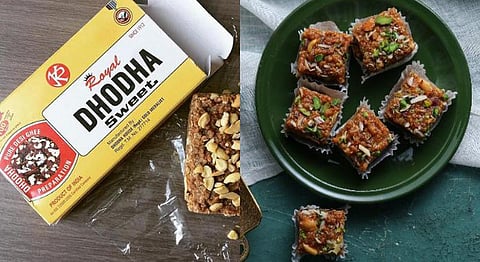
- HOMEGROWN WORLD
- #HGCREATORS
- #HGEXPLORE
- #HGVOICES
- #HGSHOP
- CAREERS
- ABOUT US
- CONTACT US

Indian desserts are a thing of wonder – the sickly sweet treats are intolerable to many, but beloved to most. The way a boondi laddoo falls apart, the silver sheen atop a kaju katli, and the drenched goodness of rasmalai; all things Indians hold close to their hearts. Suited mainly for the South Asian palate, these sweets are in no way restricted to the region, but their cultural history remains grounded here.
One of these gems, the dodha barfi, has a rather peculiar history attached to it. The gooey, sticky, deep golden-brown barfi that is usually shaped into rectangular cubes is cherished by Indians across the subcontinent, but it comes from the region up north, Punjab.
Pre-partition, in 1912, in the Sarghoda district (now in Pakistan) of Punjab, there existed a man by the name of Harbans Vig. As mighty as his name sounds, it lives up to his occupation of being a wrestler. As we all know, and as we have been told by the multiple wrestler-themed Bollywood films, wrestlers need their hearty amount of nutrition. Litres of milk and ghee by the kilo, Indian wrestlers, especially from Punjab, are true believers of shudh poshan (pure nutrition).
Our protagonist, Harbans Vig, was one of these wrestlers. But the unexciting taste of milk and monotony of ghee got to him, and he decided to make something out of the ingredients he had to consume, as such. Harbans headed to the kitchen and began trying to whip up something out of milk, malaai or cream, sugar, dried nuts and of course, ghee. The victorious resultant was a fudgy and most-likely-to-get-stuck-in-your-teeth substance, which came to be called dodha. When formed into manageable shapes, the dodha barfi was born.
The sweet preparation gained popularity amongst wrestlers, and some would even travel to Harbans’ household to try it. Soon, it started being churned out and sold through their family shop.
The Vig family, at the time of partition, moved to Kotkapura, Punjab in India. The family that bought their house and shop in Pakistan continue to keep their legacy alive, and the street there is named after dodha. The same can be found in Kotkapura in India – Dodha Chowk! Now, the Royal Dodha House even exports the dessert.
Harbans Vig’s great-grandson, Vipin Vig is now the Managing Director of Royal Dodha House. As a symbol of honour for his great grandfather, the box in which he stored his daily earnings, almost 100 years old, is placed at the maker’s office.
One of the most iconic Indian sweets of all time, the dodha barfi feels sweeter knowing its humble beginning. Harbans’ somewhat-accidental invention is now a supremely loved food devoured at special occasions, and sometimes even sneakily gorged on from time to time.
If you enjoyed reading this, we suggest you also read:
